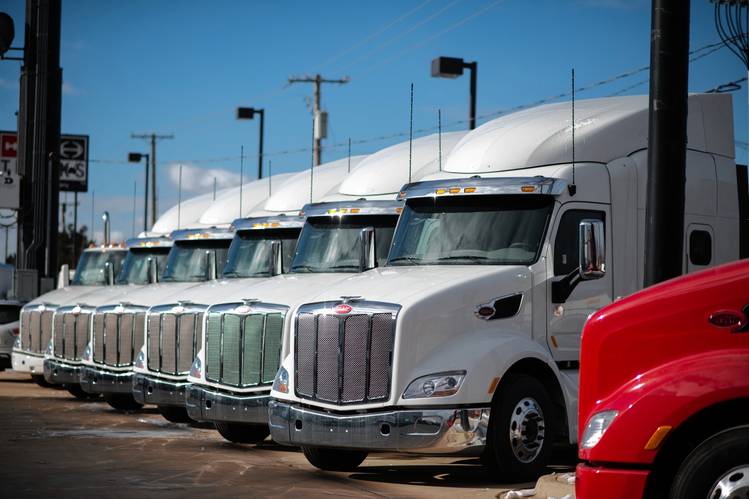onnectivity has raised the bar about what fleets expect when they bring their trucks into the dealership for service, says Rick Reynolds, president and dealer principal at Peach State Truck Centers and ATD/HDT/Procede Software Truck Dealer of the Year. “They expect that we should be able to diagnose the problem quicker, and with that quicker diagnosis communicate with them about what is occurring throughout the repair,” he says, adding that their expectations are “very legitimate and realistic.” He sees one of the benefits of connectivity as eliminating waste and adding as much efficiency as possible.
John Arscott, CEO and dealer principal at The Pete Store and ATD/HDT 2018 Truck Dealer of the Year finalist, agrees that communication is huge but adds, “Somebody might have put a bracket around uptime and put it up on a wall, but it has always been important.”
He says today it is “more about developing a service culture that includes trust, efficiency, and communication. Those three components need to work together, with communication being the biggest one.”
Jon Vandehey, president and CEO of Mid-State Truck Service Inc. and Truck Dealer of the Year nominee, believes connectivity gives his dealership the “opportunity to problem-solve with our customers and form a relationship with them. It is also another area where we can differentiate ourselves and provide additional value, because it allows us to be involved earlier in the decision-making process.”
Craig Young, president of Young Truck Sales Inc. and another Dealer of the Year nominee, says connectivity speeds up the repair process, but he adds that not all his customers like the additional communication. Some, he says, see it as an interruption to their business. He also cautions that it is imperative that the diagnosis of the problem be accurate. “You find a sensor that is bad and fix it. Everything seems okay, but 100 miles down the road the truck has a problem again.”
He says this raises the issue of how far a technician should go with the initial repair. “You get a code that tells you what the problem is and you fix that, but what if there is actually something else that is causing the problem to occur but it does not show up right away? That is frustrating for the customer.”
According to Lee White, president of Old River Companies Inc. and a Truck Dealer of the Year nominee, increased connectivity puts pressure on dealers to complete repairs faster, but also lessens the interaction customers have with dealership personnel, because they often get notification of problems directly through OEM programs rather than through the dealership.
To combat the complications connectivity brings, nominee Mark Bergey, president of Bergey’s Truck Center, has added an aftermarket specialist to his staff. “He goes out and helps our customers understand all the different programs and applications so they can leverage what’s out there.”
Nominee Joe Alosa, president and CEO of New England Kenworth, believes one of the challenges facing dealers today is “getting the proper people in place to handle and disseminate the information to the customer in a timely fashion so he knows whether he is going to be tied up for five minutes, five hours, or five days.”
He adds, “It is important that I instruct our people that there is no such thing as the word ‘no’ when someone calls for service support, because he has the right to know whether he is in trouble for a day or for a longer period of time.” Alosa says this is especially true in his market areas, because New England Kenworth customers tend to be smaller companies that don’t have standby or replacement units available.
Spec’ing trends
The Dealer of the Year candidates made note of two significant spec’ing trends. Vandehey says, “One is geared toward safety and the other is geared toward the driver.”
Arscott says the biggest driver-related change has been the move to automated transmissions. “Over the last 24 months Peterbilt has gone from about 10% AMTs to 60%.” He says he is seeing this move in his vocational customers. “We saw it before in trash trucks, but now we are seeing it in dump trucks and ready-mix trucks.” He believes this is in part a reaction to the driver shortage and fleets adapting to a driver pool that includes people with no experience driving a standard transmission.
Young says customers are interested in more luxurious interiors and more driver amenities. “It is what they need to attract drivers,” he believes.
When it comes to safety, Reynolds says he has seen “a tremendous reception and adoption of safety systems.” White agrees and adds that dealers should work hard at selling customers on the benefits of advanced safety systems. He is such a big believer in them that he even specs them on his dealership’s rental fleet.
But AMTs and safety are not the only spec’ing trends dealers notice. There has also been a move to integrated powertrains, according to Arscott. “We are talking about vertical integration with ‘talk’ between components, and that is going to benefit the customer because those systems are designed to work together,” he explains.
White says he has noticed a shift to smaller-displacement engines, specifically 13-liter engines. “For the most part, today’s 13-liter engines with their torque and horsepower are equivalent to what 16-liter engines used to be, so there is no reason not to go with a smaller-displacement engine.”
“There is also the whole aerodynamic and fuel economy issues,” Bergey says. “Years ago, all fleets wanted was heavy horsepower. Today, they are more concerned about fuel economy and in spec’ing the truck that will get them the best fuel economy.”
He adds that fleets expect the dealer to be the expert who ensures they maximize the truck for fuel efficiency.
Keeping up with disruptive trends
Platooning, autonomous, trucks and electric-powered trucks are just a few of the things that have been identified as bringing major disruption to the trucking industry. We asked the nominees what they are doing to stay on top of these trends and to put themselves in a position to be sources of information for customers.
“Everyone is trying to figure out the next big thing and how it is going to affect them and their business,” Vandehey says. “We are actively involved in trying to figure that out and adapt to it and hopefully at some point embrace it.”
Dealers are not united as to which technology they think will come to market first.
White says autonomous trucks are getting the most interest from his customers because of the driver shortage situation. “But neither my customers nor I see a driverless truck any time soon, because there still needs to be a lot of changes in state and federal regulations. We are just trying to make sure that everyone at the dealership is up to speed on what’s going on in the industry. We are trying to learn all we can so that if our customer asks a question,we have a good answer for them.”
Arscott says he has already had many conversations with customers on market disruptions. He relies on his OEM to show his customers the advanced technologies it is working on, so he routinely takes customers to the Peterbilt factory to meet with company officials. “The first autonomous vehicle I was involved with was six years ago. And since then, OEMs have been playing with it and have been fairly open about showing customers what they are doing. The implementation of this is coming down the pike. At what point it will be here, I am not sure.”
He adds, “These technologies [autonomous and electric trucks] are going to change the world, but it might not be quite at the lightning speed that the [smartphone] did.”
Reynolds says he is intrigued by all the new technology. “The Tesla and Nikola presentations are all very positive. Concerning electric vehicles, it is interesting to read about them and I think there is a place for them in the industry. However, I don’t have my arms wrapped around the Class 8 piece of that equation simply because it is still so new and there is so much to work through as far as battery weight, range, etc. But I do see it in the pickup and delivery market.”
He says he is going to continue to watch developments to stay on top of things. “The other issue to be aware of with electric trucks is those things run on fewer parts and parts that don’t break. There is an aspect of that that could significantly change the business model for commercial truck dealers. I have no idea what that would look like, but the simple fact of the matter is that there will be fewer parts to break.”
Young has customers who have already placed orders for Tesla and Nikola trucks. “We are on the verge of a real revolution in our industry,” he says. “But I think we are wrong thinking of the Nikolas and Teslas as truck manufacturers. To me, Tesla is a battery company and Nikola is a power company.”
He believes acceptance of these products will start out slowly in the trucking industry. “It will be slow, slow, slow – and then it will suddenly boom. That is where I see us now; we are at the very start of that process, and when it hits and takes off, those who aren’t on the leading edge will be left behind.” His plan is to be on the leading edge.
Complete this story on Truckinginfo

